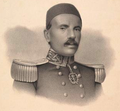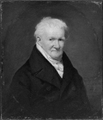- Moses Wight
-
Moses Wight (1827–1895) was an artist in Boston, Massachusetts and Paris in the 19th-century. He painted portraits of Edward Everett, Louis Agassiz, Charles Sumner, Alexander von Humboldt, and other notables.
Contents
Biography
Wight "began the practice of art as a profession in 1845 ... devoting himself chiefly to portrait-painting."[1] He kept a studio in Boston on Tremont Row, nearby several other artists -- Thomas Ball; W.M. Brackett; A. Clark; Thomas Edwards; J. Greenough; William H. Hanley; A.G. Hoit; Charles Hubbard; W. Hudson, Jr.; D.C. Johnston; A.C. Morse; and Edward Seager.[2] Around this time he painted works such as "Laying the Corner-Stone of the Beacon Hill Reservoir, Nov. 22, 1847" ("containing portraits of the mayor, Josiah Quincy, Jr.; ex-mayors Josiah Quincy, Sr., and Samuel T. Armstrong; Nathan Hale, Thomas B. Curtis and James F. Baldwin, water commissioners; city marshal Francis Tukey, and members of the city council and government.")[3]
Wight travelled to Europe in 1851, and studied with Antoine A.E. Hébert and Léon Bonnat in Paris.[4] While in Berlin in 1852, Wight painted portraits of D.D. Barnard and Alexander von Humboldt. Edward Everett, also in Berlin at the time, facilitated the coveted Humboldt commission for Wight: "I reflect with pleasure that it was in my power, through the medium of my much valued friend Mr. D.D. Barnard, then our Minister at Berlin, to aid a meritorious young artist, Mr. M. Wight, in procuring an opportunity to paint the portrait of Baron Humboldt. This of course was a favor not likely to be asked of a person of such eminence, whose time was so precious, and whom so many artists were eager to paint and to model. Mr. Wight, however, succeeded so well in a portrait of Mr. Barnard, who enjoyed the intimacy of Baron Humboldt, that, on seeing it, he consented to give our young countryman four long sittings."[5] By the artist's own account "when the portrait ... was completed, many persons, citizens and strangers, as well as artists, and among the latter Cornelius ... and Rauch, together with personal friends of Humboldt, came to see it. Before the portrait was sent to America it was exhibited to the citizens in the grand hall of the Art Union of Berlin.[6]
Back in Boston, he exhibited at the gallery of the New England Art Union in 1852;[7] and the Boston Athenaeum in 1856.[8] Around 1862 he kept a studio on Washington Street.[9] "In the great fire of 1872 his studio was burned with many valuable canvases."[10]
Through his career, other portrait subjects included:
- Louis Agassiz
- Samuel Appleton[11]
- Daniel D. Barnard
- Henry H. Childs[12]
- Thomas Dowse[13][14]
- Ralph Waldo Emerson
- Edward Everett
- Prof. Pierce
- Josiah Quincy III[11]
- James Savage[11]
- Charles Sumner[15][16]
- Alexander von Humboldt[17]
- Emory Washburn
- Henry Wilson[10]
He received good press. Of his portrait of Everett, one reviewer praised: "the position is easy, graceful, and natural; the expression faithful and spirited; the face and figure show Mr. Everett as he now is. Mr. Wight is undoubtedly a painter of great ability, and this portrait alone, would gain him a very high reputation."[18]
He also had his critics, however. For instance, in 1879 "the life-size picture of 'Eve at the Fountain,' painted by Mr. Wight, now on exhibition at Childs & Co.'s gallery, is an attempt at a great work in art, but we can hardly regard it as a successful one. With all the adventitious aids given to it in the drapery about it, and the arrangement of the light, which must greatly heighten its effect, the picture seems to us to come far short of what it ought to be. We doubt whether Eve could be represented except in marble to satisfy our ideal of the innocence, purity and dignity that ought to belong to the fair mother of the race."[19]
Moving permanently to Paris, around 1890 he lived on the Boulevard Rochechouart.[10] In 1886 Wight married Leonide Labat (b.1831).[10] He died in 1895.[20]
Image gallery
- Selected works by Wight
References
- ^ Artists of the nineteenth century and their works. 1879.
- ^ Boston Directory. 1848, 1850
- ^ Catalogue of the Collections of the Bostonian Society in the Old State House Boston, 3rd ed. 1902.
- ^ Appleton's cyclopædia of American biography. 1889.
- ^ Edward Everett. The Mount Vernon papers. NY: Appleton, 1860; p.290.
- ^ M. Wight, in: P. Creed, ed. Boston Society of Natural History, 1830-1930. Boston: 1930.
- ^ Catalogue of Paintings Now on Free Exhibition at Our Gallery. Prices including Frames. Bulletin of the New England Art Union, No. 1 (1852), pp. 10-11.
- ^ The Crayon, Vol. 3, No. 8 (Aug. 1856)
- ^ Boston Directory. 1862
- ^ a b c d William Ward Wight. The Wights: a record of Thomas Wight of Dedham and Medfield and of his descendants, 1635-1890. Milwaukee: Swain & Tate, 1890; p.191-192
- ^ a b c Catalogue of the paintings, engravings, busts, & miscellaneous articles belonging to the cabinet of the Massachusetts Historical Society. 1885.
- ^ Ellen Mudge Burrill. The State House, Boston, Mass. Boston: Wright and Potter Prtg. Co., 1901.
- ^ Walter Muir Whitehill. The Centenary of the Dowse Library. Proceedings of the Massachusetts Historical Society, Third Series, Vol. 71 (Oct., 1953 - May, 1957), pp. 167-178.
- ^ The Dowse commission was facilitated once again by Edward Everett: "I recommended to him strongly the highly promising youthful artist, Mr. Wight. ... Mr. Dowse consented with the hesitation inspired by his characteristic diffidence and humility; and the result does the highest creside to Mr. Wight's artistic skill and taste." Cf. November Meeting. Decease of Mr. Dowse. Proceedings of the Massachusetts Historical Society, 1856; p.120.
- ^ "An oil portrait [of Charles Sumner] by Moses Wight (1856) is in the Boston Public Library." Appletons' cyclopaedia of American biography. 1888.
- ^ United States art directory and yearbook. 1882.
- ^ Museum of Fine Arts, Boston. The museum acquired the portrait in 1896.
- ^ Cosmopolitan Art Journal, Vol. 3, No. 2 (March 1859).
- ^ Ladies' repository: religious and literary magazine for the home circle, v.43, no.1, Jan. 1870; p.79.
- ^ WorldCat
Further reading
- Tuckerman. Book of artists, 2nd ed. 1867.
- Helmut de Terra. Studies of the Documentation of Alexander von Humboldt: The Philadelphia Abstract of Humboldt's American Travels, Humboldt Portraits and Sculpture in the United States. Proceedings of the American Philosophical Society, Vol. 102, No. 6, Studies of Historical Documents in the Library of the American Philosophical Society (Dec. 15, 1958), pp.560-589.
Categories:- 1827 births
- 1895 deaths
- American painters
- Portrait artists
- People from Boston, Massachusetts
- 19th-century people
- 19th century in Boston, Massachusetts
Wikimedia Foundation. 2010.







